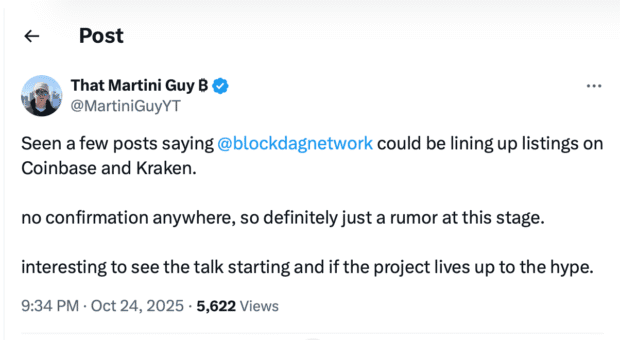Key takeaways
The real edge in crypto trading lies in detecting structural fragility early, not in predicting prices.
ChatGPT can merge quantitative metrics and narrative data to help identify systemic risk clusters before they lead to volatility.
Consistent prompts and verified data sources can make ChatGPT a dependable market-signal assistant.
Predefined risk thresholds strengthen process discipline and reduce emotion-driven decisions.
Preparedness, validation and post-trade reviews remain essential. AI complements a trader’s judgment but never replaces it.
The true edge in crypto trading comes not from predicting the future but from recognizing structural fragility before it becomes visible.
A large language model (LLM) like ChatGPT is not an oracle. It’s an analytical co-pilot that can quickly process fragmented inputs — such as derivatives data, onchain flows and market sentiment — and turn them into a clear picture of market risk.
This guide presents a 10-step professional workflow to convert ChatGPT into a quantitative-analysis co-pilot that objectively processes risk, helping trading decisions stay grounded in evidence rather than emotion.
Step 1: Establish the scope of your ChatGPT trading assistant
ChatGPT’s role is augmentation, not automation. It enhances analytical depth and consistency but always leaves the final judgment to humans.
Mandate:
The assistant must synthesize complex, multi-layered data into a structured risk assessment using three primary domains:
Derivatives structure: Measures leverage buildup and systemic crowding.
Onchain flow: Tracks liquidity buffers and institutional positioning.
Narrative sentiment: Captures emotional momentum and public bias.
Red line:
It never executes trades or offers financial advice. Every conclusion should be treated as a hypothesis for human validation.
Persona instruction:
“Act as a senior quant analyst specializing in crypto derivatives and behavioral finance. Respond in structured, objective analysis.”
This ensures a professional tone, consistent formatting and clear focus in every output.
This augmentation approach is already appearing in online trading communities. For example, one Reddit user described using ChatGPT to plan trades and reported a $7,200 profit. Another shared an open-source project of a crypto assistant built around natural-language prompts and portfolio/exchange data.
Both examples show that traders are already embracing augmentation, not automation, as their central AI strategy.
Step 2: Data ingestion
ChatGPT’s accuracy depends entirely on the quality and context of its inputs. Using pre-aggregated, high-context data helps prevent model hallucination.
Data hygiene:
Feed context, not just numbers.
“Bitcoin open interest is $35B, in the 95th percentile of the past year, signaling extreme leverage buildup.”
Context helps ChatGPT infer meaning instead of hallucinating.
Step 3: Craft the core synthesis prompt and output schema
Structure defines reliability. A reusable synthesis prompt ensures the model produces consistent and comparable outputs.
Prompt template:
“Act as a senior quant analyst. Using derivatives, onchain and sentiment data, produce a structured risk bulletin following this schema.”
Output schema:
Systemic leverage summary: Assess technical vulnerability; identify primary risk clusters (e.g., crowded longs).
Liquidity and flow analysis: Describe onchain liquidity strength and whale accumulation or distribution.
Narrative-technical divergence: Evaluate whether the popular narrative aligns or contradicts technical data.
Systemic risk rating (1-5): Assign a score with a two-line rationale explaining vulnerability to a drawdown or spike.
Example rating:
“Systemic Risk = 4 (Alert). Open interest in 95th percentile, funding turned negative, and fear-related terms rose 180% week over week.”
Structured prompts like this are already being tested publicly. A Reddit post titled “A guide on using AI (ChatGPT) for scalping CCs” shows retail traders experimenting with standardized prompt templates to generate market briefs.
Step 4: Define thresholds and the risk ladder
Quantification transforms insights into discipline. Thresholds connect observed data to clear actions.
Example triggers:
Leverage red flag: Funding remains negative on two or more major exchanges for more than 12 hours.
Liquidity red flag: Stablecoin reserves drop below -1.5σ of the 30-day mean (persistent outflow).
Sentiment red flag: Regulatory headlines rise 150% above the 90-day average while DVOL spikes.
Risk ladder:
Following this ladder ensures responses are rule-based, not emotional.
Step 5: Stress-test trade ideas
Before entering any trade, use ChatGPT as a skeptical risk manager to filter out weak setups.
Trader’s input:
“Long BTC if 4h candle closes above $68,000 POC, targeting $72,000.”
Prompt:
“Act as a skeptical risk manager. Identify three critical non-price confirmations required for this trade to be valid and one invalidation trigger.”
Expected response:
Whale inflow ≥ $50M within 4 hours of breakout.
MACD histogram expands positively; RSI ≥ 60.
No funding flip negative within 1 hour post-breakout. Invalidation: Failure on any metric = exit immediately.
This step transforms ChatGPT into a pre-trade integrity check.
Step 6: Technical structure analysis with ChatGPT
ChatGPT can apply technical frameworks objectively when provided with structured chart data or clear visual inputs.
Input:
ETH/USD range: $3,200-$3,500
POC = $3,350
LVN = $3,400
RSI = 55
MACD = shrinking histogram after bullish crossover
Prompt:
“Act as a market microstructure analyst. Assess POC/LVN strength, interpret momentum indicators and outline bullish and bearish roadmaps.”
Example insight:
LVN at $3,400 likely rejection zone due to reduced volume support.
Shrinking histogram implies weakening momentum; probability of retest at $3,320 before trend confirmation.
This objective lens filters bias from technical interpretation.
Step 7: Post-trade evaluation
Use ChatGPT to audit behavior and discipline, not profit and loss.
Example:
Short BTC at $67,000 → moved stop loss early → -0.5R loss.
Prompt:
“Act as a compliance officer. Identify rule violations and emotional drivers and suggest one corrective rule.”
Output might flag fear of profit erosion and suggest:
“Stops can only move to breakeven after 1R profit threshold.”
Over time, this builds a behavioral improvement log, an often-overlooked but critical edge.
Step 8: Integrate logging and feedback loops
Store each daily output in a simple sheet:
Weekly validation reveals which signals and thresholds performed; adjust your scoring weights accordingly.
Cross-check every claim with primary data sources (e.g., Glassnode for reserves, The Block for inflows).
Step 9: Daily execution protocol
A consistent daily cycle builds rhythm and emotional detachment.
Morning briefing (T+0): Collect normalized data, run the synthesis prompt and set the risk ceiling.
Pre-trade (T+1): Run conditional confirmation before executing.
Post-trade (T+2): Conduct a process review to audit behavior.
This three-stage loop reinforces process consistency over prediction.
Step 10: Commit to preparedness, not prophecy
ChatGPT excels at identifying stress signals, not timing them. Treat its warnings as probabilistic indicators of fragility.
Validation discipline:
Always verify quantitative claims using direct dashboards (e.g., Glassnode, The Block Research).
Avoid over-reliance on ChatGPT’s “live” information without independent confirmation.
Preparedness is the real competitive edge, achieved by exiting or hedging when structural stress builds — often before volatility appears.
This workflow turns ChatGPT from a conversational AI into an emotionally detached analytical co-pilot. It enforces structure, sharpens awareness and expands analytical capacity without replacing human judgment.
The objective is not foresight but discipline amid complexity. In markets driven by leverage, liquidity and emotion, that discipline is what separates professional analysis from reactionary trading.


